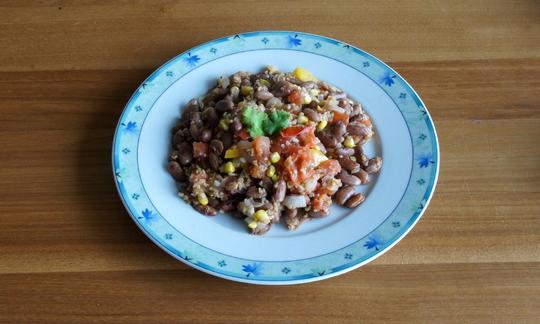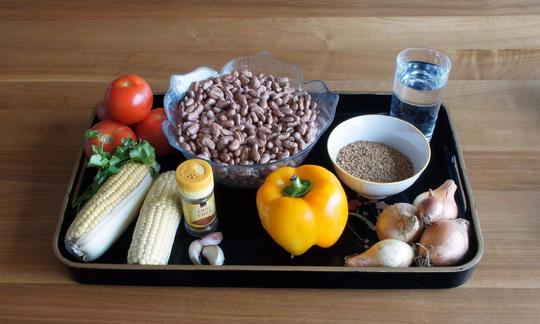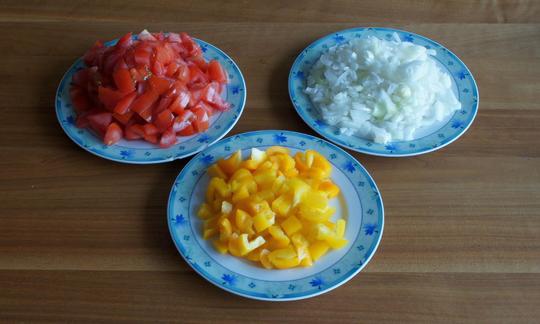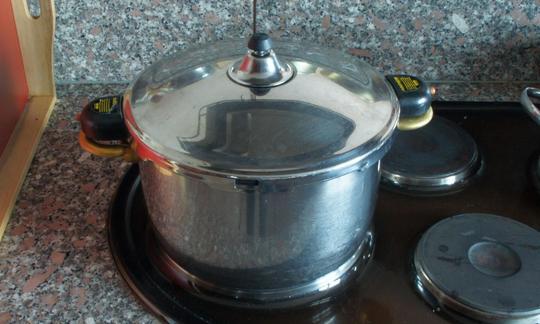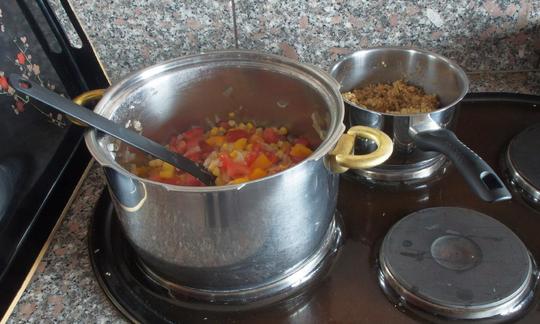Tailgate chili with borlotti beans with corn on the cob, tom
vegan
Ingredients (for servings, )
| For the bean-vegetable base | |
|---|---|
| 18 oz | Borlotti beans, raw (organic?) |
| 2 | Corn cobs, raw (sweet corn, organic?) (21 oz) |
| 3 | Onions, raw (organic?) (12 oz) |
| 3 | Tomatoes, raw (organic?) (19 oz) |
| 1 | Sweet pepper, yellow, raw (organic?) (5.5 oz) |
| 3 cloves | Garlic (organic?) (0.32 oz) |
| 1 tbsp | Chili powder (raw?, organic?) (0.28 oz) |
| For the bulgur | |
| 250 ml | Drinking water, raw (organic?) (8.8 oz) |
| 3 ½ oz | Bulgur, dry (not raw, organic?) |
| For garnishing | |
| 2 sprigs | Coriander leaves, raw (0.16 oz) |
Equipment
- garlic press
- stove
- saucepan
- pressure cooker
Type of preparation
- cook
- steam
- soak
- sweat
Preparation
For the bean-vegetable base
Soak the borlotti beans in cold water overnight or for at least 4 hours.Steam the beans in a pressure cooker for 30 minutes. In the meantime, continue preparing the other ingredients.
If you don't have a pressure cooker, you can also use a regular saucepan. However, in this case, the preparation will take up to three times longer.
Bring water to a boil, add the corn cobs and simmer over medium heat for 15 minutes. While the corn is cooking, carry out the next preparation step.
The corn cobs should not be very soft or tender after cooking, as we will cook them with the remaining ingredients at a later time.
Cut the onions, tomatoes and peppers into small pieces. Mince the garlic cloves using a garlic press.
Remove the corn cobs from the pot and rinse under cold water until they are easy to handle. Hold the cobs vertically, use a knife to remove the kernels from top to bottom and add them to the rest of the vegetables.
Remove the steamed beans from the pressure cooker and let them cool.
You should only proceed to the next step once the beans are ready. If you don't have a pressure cooker, the next step will be significantly delayed.
Put 2 tablespoons of water in a saucepan and heat, add onions and garlic and sauté until almost soft (about 5 minutes).
Add peppers, tomatoes, beans, corn and chili powder to the onion and garlic mixture. Simmer on medium heat for about 10 minutes and then proceed to the next preparation step.
There should be enough liquid from the tomatoes, otherwise add a little more water.
For the bulgur
Put the bulgur and water in a pot. Bring to the boil, reduce the heat and simmer for 10-14 minutes (or until the water has evaporated).When the bean and vegetable base and the bulgur are well done, mix everything together and cook again for 5 minutes on medium heat.
For garnishing
Divide the "Tailgate Chili with Borlotti Beans" between plates and garnish with coriander.
|
Nutritional Information per person
Convert per 100g
|
2000 kcal | |
|---|---|---|
| Energy | 794 kcal | 39.7% |
| Fat/Lipids | 6.4 g | 9.1% |
| Saturated Fats | 1.1 g | 5.4% |
| Carbohydrates (inc.dietary fiber) | 156 g | 57.7% |
| Sugars | 9.8 g | 10.9% |
| Fiber | 37 g | 148.4% |
| Protein/Albumin | 36 g | 72.6% |
| Cooking Salt (Na:98.2 mg) | 249 mg | 10.4% |
| Essential micronutrients with the highest proportions | per person | 2000 kcal | |
|---|---|---|---|
| Vit | Vitamin B9, B11 (Folate, as the active form of folic acid) | 665 µg | 332.0% |
| Prot | Tryptophan (Trp, W) | 0.39 g | 158.0% |
| Prot | Threonine (Thr, T, irreversibly transaminated) | 1.4 g | 153.0% |
| Min | Copper, Cu | 1.3 mg | 130.0% |
| Prot | Leucine (Leu, L) | 3.1 g | 129.0% |
| Prot | Phenylalanine (Phe, F) | 1.8 g | 119.0% |
| Prot | Isoleucine (Ile, I) | 1.5 g | 118.0% |
| Min | Manganese, Mn | 2.3 mg | 114.0% |
| Vit | Vitamin B1 (Thiamine) | 1.2 mg | 112.0% |
| Prot | Valin (Val, V) | 1.8 g | 112.0% |
Detailed Nutritional Information per Person for this Recipe
The majority of the nutritional information comes from the USDA (US Department of Agriculture). This means that the information for natural products is often incomplete or only given within broader categories, whereas in most cases products made from these have more complete information displayed.
If we take flaxseed, for example, the important essential amino acid ALA (omega-3) is only included in an overarching category whereas for flaxseed oil ALA is listed specifically. In time, we will be able to change this, but it will require a lot of work. An “i” appears behind ingredients that have been adjusted and an explanation appears when you hover over this symbol.
For Erb Muesli, the original calculations resulted in 48 % of the daily requirement of ALA — but with the correction, we see that the muesli actually covers >100 % of the necessary recommendation for the omega-3 fatty acid ALA. Our goal is to eventually be able to compare the nutritional value of our recipes with those that are used in conventional western lifestyles.
| Essential fatty acids | per person | 2000 kcal |
|---|---|---|
| Linoleic acid; LA; 18:2 omega-6 | 2.5 g | 25.0% |
| Alpha-Linolenic acid; ALA; 18:3 omega-3 | 0.32 g | 16.0% |
| Essential amino acids | per person | 2000 kcal |
|---|---|---|
| Tryptophan (Trp, W) | 0.39 g | 158.0% |
| Threonine (Thr, T, irreversibly transaminated) | 1.4 g | 153.0% |
| Leucine (Leu, L) | 3.1 g | 129.0% |
| Phenylalanine (Phe, F) | 1.8 g | 119.0% |
| Isoleucine (Ile, I) | 1.5 g | 118.0% |
| Valin (Val, V) | 1.8 g | 112.0% |
| Lysine (Lys, K, irreversibly transaminated) | 2.0 g | 106.0% |
| Methionine (Met, M) | 0.58 g | 62.0% |
| Vitamins | per person | 2000 kcal |
|---|---|---|
| Vitamin B9, B11 (Folate, as the active form of folic acid) | 665 µg | 332.0% |
| Vitamin B1 (Thiamine) | 1.2 mg | 112.0% |
| Vitamin C (ascorbic acid) | 78 mg | 98.0% |
| Vitamin B6 (pyridoxine) | 1.2 mg | 87.0% |
| Vitamin B3 (Niacin) | 7.0 mg | 43.0% |
| Vitamin B2 (Riboflavin) | 0.48 mg | 34.0% |
| Vitamin B5 (Pantothenic acid) | 1.6 mg | 27.0% |
| Vitamin B7 (Biotin, ex vitamin H) | 11 µg | 21.0% |
| Vitamin K | 14 µg | 19.0% |
| Vitamin E, as a-TEs | 1.7 mg | 14.0% |
| Vitamin A, as RAE | 86 µg | 11.0% |
| Essential macroelements (macronutrients) | per person | 2000 kcal |
|---|---|---|
| Potassium, K | 2'137 mg | 107.0% |
| Phosphorus, P | 682 mg | 97.0% |
| Magnesium, Mg | 329 mg | 88.0% |
| Calcium, Ca | 180 mg | 23.0% |
| Sodium, Na | 98 mg | 12.0% |
| Essential trace elements (micronutrients) | per person | 2000 kcal |
|---|---|---|
| Copper, Cu | 1.3 mg | 130.0% |
| Manganese, Mn | 2.3 mg | 114.0% |
| Zinc, Zn | 6.5 mg | 65.0% |
| Iron, Fe | 8.8 mg | 63.0% |
| Selenium, Se | 15 µg | 28.0% |
| Iod, I (Jod, J) | 5.4 µg | 4.0% |
| Fluorine, F | 40 µg | 1.0% |
This "Tailgate Chili with Borlotti Beans" is a hearty dish that you can easily modify as you like. Here with corn on the cob and tomatoes.
Optimal coordination: The difficulty with this recipe lies in the correct division of the preparation steps. The aim is to reduce waiting time, but not to unintentionally prolong certain cooking processes. If you don't have a steamer or pressure cooker, you will need to allow more time for the beans to cook. You should also delay the subsequent preparation steps accordingly.
Information about Borlotti beans: Borlotti beans originally come from Central and South America. They take on a slightly redder color when cooked. While the large beans are often used in Italy for minestrone, the small, soft-cooking ones are better suited for stews like this tailgate chili.
Corn: Corn is a vitamin-rich crop with a high fiber content. The center of corn cultivation is in central Mexico. Remains from pre-Columbian times have been found in Mexico, Panama and Peru. After his discovery, Christopher Columbus brought corn cobs back to Europe, where they were grown in Spanish fields from 1525 onwards. Fresh corn from the field tastes best and goes very well with salads or stews. Outside of the season, corn is usually only available in canned form. In addition to eating it directly, it can also be processed further, with dried kernels being ideal for making polenta or baked goods.
Sweet peppers (yellow): Ripe peppers have different color compositions depending on the variety. However, among ordinary sweet peppers, only the green peppers are unripe. This is due to the green color pigment chlorophyll, which overshadows the carotenoids responsible for the typical coloring of peppers and loses intensity during the ripening process. Contrary to a widespread assumption, orange and yellow peppers are not a precursor to red peppers. You can test this yourself by placing the more bitter-tasting green peppers with ripe apples. The ripening gas ethylene emitted by the apples changes the color of the peppers without any intermediate stage. The color is therefore a question of variety.
Cutting onions and tears: The inevitable destruction of the cell structure when cutting onions leads to the release of the amino acid isoalliin from the cell plasma. This is a double-bond isomer of the sulphur-containing amino acid alliin, which is also found naturally in garlic or wild garlic, for example. But it alone does not cause a burning sensation. This requires a corresponding enzyme, the so-called alliinase, which is located in the cell vacuole. The suffix "-ase" in this case simply means that this enzyme breaks down chemical or organic compounds, i.e. in this case it causes a conversion of the isoalliin. Only an injury to the cell walls causes the two ingredients housed in two different cell compartments to come together. The resulting reactions sometimes lead to the formation of the compound propanthial-S-oxide. The plant uses the reaction mentioned to defend itself against predators or microbes. However, this substance also irritates our mucous membranes when it comes into contact, causing us to secrete tears as a counter-reaction.
Quick option: Buy the beans in a can from the supermarket, but preferably without salt. This eliminates the soaking time and also reduces the cooking time. However, canned beans cannot compete in terms of taste and, depending on the quality, they fall apart quickly.
As with beans, you can save time by using canned corn, but the quality of the dish may suffer.
Fewer tears when cutting onions: There are various household tricks that can reduce or even prevent the flow of tears when cutting onions. On the one hand, using a sharp knife helps to keep the number of destroyed cell structures to a minimum, which means that slightly less of the mucous membrane-irritating propanthial-S-oxide escapes. On the other hand, "cooling" the onion in the refrigerator (about 15 minutes is enough) helps to reduce the amount of acid enzymes released into the air. Other methods range from cutting next to a strong extractor, using a fan, wearing lenses and chewing bread to taking a sip of water in your mouth while cutting onions. The latter do not work for everyone and it is up to you which method works best for you.
Beans: You can easily replace the borlotti beans with other types of beans, such as kidney beans or white beans.
Spices: Depending on your taste or cooking method, more spices are desired. Instead of salt, you can also use a little vegetable stock or, if you don't like the chili spicy enough, add a peperoncini to it. Peppercorns also provide a fruity, spicy note.
Replace coriander: Coriander is a hereditary matter of taste. If you like to use other herbs, you can use fresh parsley, for example. Although this is often done, parsley does not offer a comparable substitute in terms of taste.
Canned corn: If you don't have fresh corn cobs at home, you can also usecanned corn. However, you should pay attention to the quality and additives. It is recommended that you rinse the canned kernels with tap water before further processing and then let them drain.

